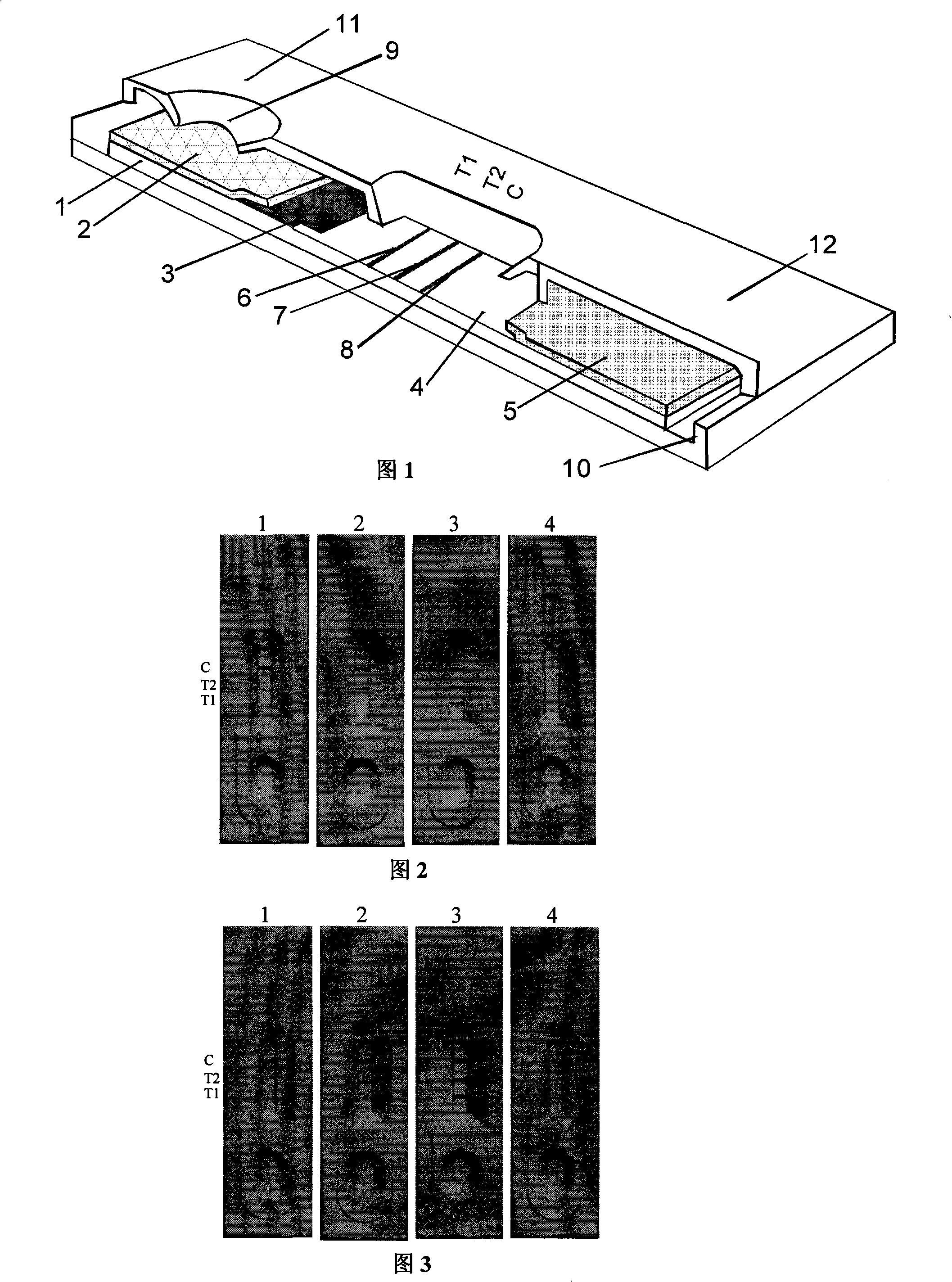Porcine circovirus PCV1 and PCV2 identifying and detecting test paper card
A technology of differential detection and test strip card, applied in the biological field, can solve the problems of inability to realize the differential diagnosis of PCV2 antigen subtypes, difficulty in popularization and promotion, complicated test operation, etc., and achieve simple and fast operation, vivid test results, and high sensitivity Effect
- Summary
- Abstract
- Description
- Claims
- Application Information
AI Technical Summary
Problems solved by technology
Method used
Image
Examples
Embodiment 1
[0021] The preparation of embodiment 1 capsid protein recombinant protein
[0022] High-efficiency expression of PCV1 and PCV2 capsid proteins by genetic engineering technology to prepare recombinant capsid proteins. According to PCV1 isolates (GenBank No.AY193712) and 1767 PCV2 isolate HZ0201 (GenBank No. AY188355) complete gene sequence, designed PCV1 and PCV2 capsid protein-specific primers respectively, PCV1 upstream primer is PV1up: 5'-GCGGATCCACGGGTATCTTCAATTC-3', containing BamHI restriction site, PCV1 downstream primer For PV1down: 5'-CCGCTCGAGTTATTTTATTTAGAGGGTC-3', containing XhoI restriction site, PCV2 upstream primer is pG1: 5'-GC GGATCC AATGGCATCTTCAACAC-3', containing BamHI restriction site; PCV2 downstream primer pG2: 5'-CCG CTCGAG TTAAGGGTTAAGTGGG-3', containing XhoI restriction site. Using PCV1 and PCV2 viral DNA as templates, amplify the 573bp and 579bp enucleation localization signal capsid protein genes, the reaction conditions are: 95°C for 30s, 58 or ...
Embodiment 2
[0025] Example 2 Preparation and screening of anti-capsid protein monoclonal antibody
[0026] Mix the recombinant PCV1 and PCV2 capsid proteins with Freund's adjuvant in equal amounts, fully emulsify, and immunize BALB / c mice with 50g-100g / mouse for 3 times with an interval of 15-30 days; the third booster immunization After 3-4 days, bleed the eyeballs of the immunized mice, pull the neck to death, soak in 75% alcohol for 5-10 minutes, and aseptically collect the splenocytes; cut them into pieces and filter them through a 100-mesh nylon mesh, centrifuge at 1000r / min for 10 minutes, and collect splenocytes; mix 1×10 8 splenocytes with 2-5 x 10 7 Mix SP2 / 0 myeloma cells, centrifuge at 1000r / min for 10min, discard the supernatant, slowly add 0.7-1ml of 40%-50% PEG 4000 (pH8.5-9.0) to the cells in a water bath at 37°C, and warm After incubating for 1 min, slowly add 15 ml of serum-free 1640 medium to terminate the effect of PEG, bathe in 37°C for 5-10 min, centrifuge at 1000 r...
Embodiment 3
[0027] Example 3 Screening of anti-capsid protein monoclonal antibodies
[0028] The 25 anti-capsid monoclonal antibodies were screened and identified by indirect immunofluorescence (IFA). Separate PCV1 isolates, 1768 PCV2 isolates, 1767 PCV2 isolates and 1766 PCV2 isolates were inoculated with trypsinized PK-15 cells without PCV contamination at a ratio of 1:10, and the virus cell mixture was added to a 96-well cell culture plate, 100 μL per well, at 37°C in 5% CO 2 After culturing for 96 h, add 100 μL of methanol-acetone fixative mixed at 1:1, and fix at -20°C for 20 min. Discard the fixative and let it dry naturally. Block with 5% skimmed milk powder for 1 hour, add 100 μL of hybridoma supernatant to each well, incubate at 37°C for 1 hour, wash 5 times with PBST, add 50 μL of FITC-labeled goat anti-mouse IgG diluted 1:400, and incubate at 37°C for 40 minutes , washed 5 times with PBST. Add 50 μL of PBS, observe positive cells with an inverted fluorescent microscope, a...
PUM
| Property | Measurement | Unit |
|---|---|---|
| Diameter | aaaaa | aaaaa |
Abstract
Description
Claims
Application Information
 Login to View More
Login to View More - R&D
- Intellectual Property
- Life Sciences
- Materials
- Tech Scout
- Unparalleled Data Quality
- Higher Quality Content
- 60% Fewer Hallucinations
Browse by: Latest US Patents, China's latest patents, Technical Efficacy Thesaurus, Application Domain, Technology Topic, Popular Technical Reports.
© 2025 PatSnap. All rights reserved.Legal|Privacy policy|Modern Slavery Act Transparency Statement|Sitemap|About US| Contact US: help@patsnap.com

